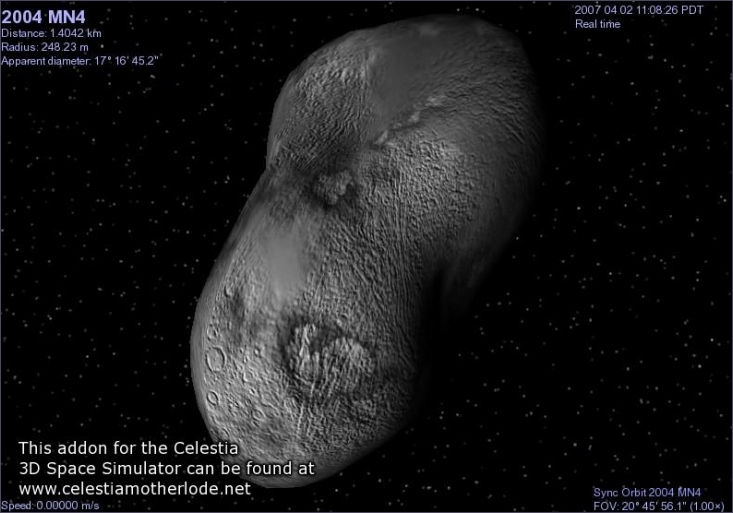Using updated information, NASA scientists have recalculated the path of a large asteroid. The refined path indicates a significantly reduced likelihood of a hazardous encounter with Earth in 2036.
The Apophis asteroid is approximately the size of two-and-a-half football fields. The new data were documented by near-Earth object scientists Steve Chesley and Paul Chodas at NASA's Jet Propulsion Laboratory in Pasadena, Calif. They will present their updated findings at a meeting of the American Astronomical Society's Division for Planetary Sciences in Puerto Rico on Oct. 8.
"Apophis has been one of those celestial bodies that has captured the public's interest since it was discovered in 2004," said Chesley. "Updated computational techniques and newly available data indicate the probability of an Earth encounter on April 13, 2036, for Apophis has dropped from one-in-45,000 to about four-in-a million."
A majority of the data that enabled the updated orbit of Apophis came from observations Dave Tholen and collaborators at the University of Hawaii's Institute for Astronomy in Manoa made. Tholen pored over hundreds of previously unreleased images of the night sky made with the University of Hawaii's 2.2-meter (88-inch) telescope, located near the summit of Mauna Kea.
Tholen made improved measurements of the asteroid's position in the images, enabling him to provide Chesley and Chodas with new data sets more precise than previous measures for Apophis. Measurements from the Steward Observatory's 2.3 meter (90-inch) Bok telescope on Kitt Peak in Arizona and the Arecibo Observatory on the island of Puerto Rico also were used in Chesley's calculations.
The information provided a more accurate glimpse of Apophis' orbit well into the latter part of this century. Among the findings is another close encounter by the asteroid with Earth in 2068 with chance of impact currently at approximately three-in-a-million. As with earlier orbital estimates where Earth impacts in 2029 and 2036 could not initially be ruled out due to the need for additional data, it is expected that the 2068 encounter will diminish in probability as more information about Apophis is acquired.
Initially, Apophis was thought to have a 2.7 percent chance of impacting Earth in 2029. Additional observations of the asteroid ruled out any possibility of an impact in 2029. However, the asteroid is expected to make a record-setting -- but harmless -- close approach to Earth on Friday, April 13, 2029, when it comes no closer than 29,450 kilometers (18,300 miles) above Earth's surface.
"The refined orbital determination further reinforces that Apophis is an asteroid we can look to as an opportunity for exciting science and not something that should be feared," said Don Yeomans, manager of the Near-Earth Object Program Office at JPL. "The public can follow along as we continue to study Apophis and other near-Earth objects by visiting us on our AsteroidWatch Web site and by following us on the @AsteroidWatch Twitter feed."
The science of predicting asteroid orbits is based on a physical model of the solar system which includes the gravitational influence of the sun, moon, other planets and the three largest asteroids.
NASA detects and tracks asteroids and comets passing close to Earth using both ground and space-based telescopes. The Near-Earth Object Observations Program, commonly called "Spaceguard," discovers these objects, characterizes a subset of them and plots their orbits to determine if any could be potentially hazardous to our planet.
JPL manages the Near-Earth Object Program Office for NASA's Science Mission Directorate in Washington. JPL is a division of the California Institute of Technology in Pasadena. Cornell University, Ithaca, N.Y., operates the Arecibo Observatory under a cooperative agreement with the National Science Foundation in Arlington, Va.
For more information about asteroids and near-Earth objects, visit:
http://www.jpl.nasa.gov/asteroidwatch
©NASA Asteroid Watch | Gewijzigd: 8 oktober 2009, 20:56 uur, door talkyr86
De NASA heeft het risico dat de asteroïde Apophis in 2036 met de Aarde botst naar beneden herzien. Apophis werd in 2004 ontdekt en is 2,5 keer zo groot als een voetbalveld. Het hemellichaam kreeg veel aandacht omdat de mogelijkheid van een botsing met onze planeet in 2036 bestond.

Volgens nieuwe berekeningen van de NASA is die kans nu 1 op 250.000. Vooraf luidde het één op 45.000. Ook was eerst gedacht dat er 2,7 procent kans was dat Apophis in 2029 tegen ons zal knallen. Maar verdere observaties leerden snel dat die kans nul was. De steenklomp zal op 13 april 2029 op 22.208 km voorbijscheren. Dat is een nooit geziene kleine afstand in de moderne tijden.
©Hln
Met behulp van geactualiseerde informatie hebben NASA-wetenschappers de baan van de forse planetoïde Apophis opnieuw berekend.
Daaruit blijkt dat de kans dat de planetoïde in 2036 in botsing komt met de aarde gering is.
Apophis werd in 2004 ontdekt en stond direct in het middelpunt van de belangstelling, omdat er een kans van enkele procenten leek te bestaan dat hij in 2029 of 2036 op aarde zou inslaan.
De gevolgen van de inslag van deze ongeveer 270 meter grote planetoïde zouden desastreus zijn.
Inmiddels is echter gebleken dat het hoogstwaarschijnlijk zo'n vaart niet zal lopen: de botsingskans is bijgesteld tot 1 op 250.000. Wel zal Apophis op vrijdag 13 (!) april 2029 op een naar kosmische maatstaven geringe afstand van slechts 30.000 kilometer langs de aarde scheren.
©astronieuws.nl

 Nieuwe berekingen over baan van astroïde Apophis
Nieuwe berekingen over baan van astroïde Apophis




